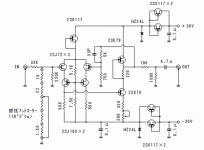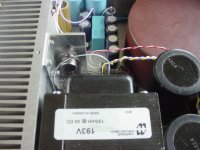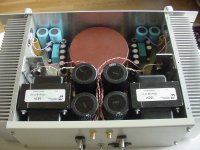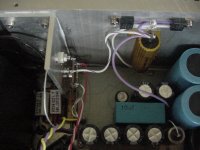Michael
Great articles !!!!
I have been using my ZenLite as a amp for my Denon DH5000 headphones.
Just wondering if anyone has tried one of Michael's as a headphone amp.
Thanks
Bob
I plan to, both with sk60 (the smaller vfet should be best suited at around 20v/0.5A, but i didnt plot any yet) and the lovoltechs of which i have a stash.
Listen ZM. Mind your own business. Not everyone is as brilliant as you.
That's the second time you crapped on me for asking a question.
You'd do well to stay out of my way. I don't care how much people like you on this board. You need some manners.
I checked 7912 doc. I'm checking in case the designer intended that way.
I don't know anything about circuit design. It not implausible that someone inexperienced would build it directly as shown.
Here's another acronym for you.
F off PITA!
That's the second time you crapped on me for asking a question.
You'd do well to stay out of my way. I don't care how much people like you on this board. You need some manners.
I checked 7912 doc. I'm checking in case the designer intended that way.
I don't know anything about circuit design. It not implausible that someone inexperienced would build it directly as shown.
Here's another acronym for you.
F off PITA!
Attached is a curve tracer plot of Id versus Vds at a number of Vgs settings for the Sony 2SK60. This is a composite of two measurements made on a Tek 576 tracer (because it normally only does up to 11 Vgs steps total), rank 6 device. This is a high voltage, low current plot, the scale is shown on the readout on the right, 50mA/div vertical (so the full height of the screen is 500mA), 20V/div horizontal (so the full width, being 12 divisions, equals 240V). Each Vgs step is -2V starting a 0V for the leftmost line. Note that the breakdown voltage is signifficantly over the 160V spec since the device operates without breakdown at 240V (don't bet on this for your particular part, 160V is guaranteed).
Note how the first few lines for low Vds are bunched together, this tendency continues to higher currents. However, if you look more to the right... I think no comment is needed.
Great info
Which vfet do you think is most suitable for high current and low voltage (something along 0,5A, 20V or even less)? I plan to use a CCS.
for an 6watt amp too
i'm just thinking of a VFET single stage preamp or buffer to have a nice triode sounding preamp to go with my SIT
if the 2SK82 is not the candidate , other VFet to grab for that ?
if the 2SK82 is not the candidate , other VFet to grab for that ?
I don't know. I remember seeing the above mentioned thread sometime back and took me a while to seach for it. Maybe you can ask Vladimirk. He seems to know a lot about vfets.
I would like to see a SIT version of the BOZ-J. Just need to find a vfet with the right criteria and with low power. But, I'm assuming a lot.
Good luck!
I think it is possible to use Corrados front stage as a pre, means the 2SK79 and the SBxx. You can even change the gain with the 5k pot.
The SK79 is available at Jim's audio eBay.
Corrado was very early occupied with the theme SIT but got not much resonance unfortunately......!

The SK79 is available at Jim's audio eBay.
Corrado was very early occupied with the theme SIT but got not much resonance unfortunately......!

Better late than never, I wish to express my thanks to Michael for his excellent article which persuaded me to dust off my previous attempts at building a sit amp. (2SK60) and to finally achieve some measure of success with the 2SK82. Thanks too to NP for his trail-blazing efforts and showing us the way in the first place. Attached pics. show the final iteration of my efforts for those who might be interested. For what it is worth, I have come to the following conclusions based on my limited efforts: 1. Listening results are greatly influenced by preamp and speaker choices. More so in my experience than with other tube and ss amps I have played with. 2. On balance I prefer inductor loading. If using resistor load, a higher B+ (100v) and correspondingly higher resistor value (40 -50 ohms) sounds better balanced. I have not tried the light bulb version. 3. I prefer self-bias (degeneration an all) to fixed-bias. If using fixed-bias, unregulated sounds better to me and has the advantage of fewer components and if derived from the same supply, would seem to address any problems with delay relative to B+ presence. 4. As previously noted by others, results of small variations in operating point are not only measurable but distinctly audible. I try to stay within 18 -20 Vds and 1.5 - 1.9 amps.
Attachments
Hi audiong,
Very nice and compact report!
You use the Hammond solution I see! And you tried the resistor solution too...wonderful.
So you mean that using 100V and a higher resistor gives not that "thinner" sound, some of us remarked, using thickfilmresistors? Is that meant by your expression "better balanced"?
Nelson uses also around 100V, and a higher load resistor, but of cause he aims for 10W.
I am still waiting for the bulbs from Dan he sent me from Canada, but in two weeks I suppose i will install the "heatballs" as two clever German engeneers called them to sell light bulbs with higher wattage despite the EU regulations.....

So on your pictures the self biasing resistor is the golden one?

Very nice and compact report!
You use the Hammond solution I see! And you tried the resistor solution too...wonderful.
So you mean that using 100V and a higher resistor gives not that "thinner" sound, some of us remarked, using thickfilmresistors? Is that meant by your expression "better balanced"?
Nelson uses also around 100V, and a higher load resistor, but of cause he aims for 10W.
I am still waiting for the bulbs from Dan he sent me from Canada, but in two weeks I suppose i will install the "heatballs" as two clever German engeneers called them to sell light bulbs with higher wattage despite the EU regulations.....
So on your pictures the self biasing resistor is the golden one?
Last edited:
Back to the BeO insulators . Because they were brought up here I will say I
have a few of the To3 style ones I can part with if anyone in THIS thread needs
a couple. One down side of these is they are realy brittle your heatsink needs to be
realy flat and you need to avoid over tightning the mounting screws. Again this
offer is only for those of you building one of these amps which is why I am not puting it in the trading post. If a moderator feals it has to be moved then this offer is null
and void.
have a few of the To3 style ones I can part with if anyone in THIS thread needs
a couple. One down side of these is they are realy brittle your heatsink needs to be
realy flat and you need to avoid over tightning the mounting screws. Again this
offer is only for those of you building one of these amps which is why I am not puting it in the trading post. If a moderator feals it has to be moved then this offer is null
and void.
Hi Generg, I did not use thick film resistors -my resistor load consisted of a string of twelve 5 ohm 50W Dale non-inductive metal-cased power resistors, series connected, allowing me to select values by tapping along the chain. I noticed progressive improvements as I increased B+ and load, all the time maintaining Vgs of around 20v, until I topped out at around 105v and 50-55 ohms. I am sure you are aware of this, but for anyone wishing to try this - make sure the voltage rating on the output coupling caps. correspond to the higher B+. What do I mean by 'better balanced' ? In a word (or two) - more bass. Not only more prominent but more tuneful. Try playing Miles Davis- Kind of Blue at low volume. The recording mix and presentation is also more satisfying, the piano on the left in Layla ( Clapton - unplugged) seems to have its blanket cover removed. The guitar and piano riffs in Old Love (same CD) are more incisive and satisfying. Diana Krall is less sibilant - Let's Face the Music and Dance etc. I am sounding too much like an audio reviewer - but you get the picture you will know it when you hear it. I was just about to freeze the design and devise ways to cope with the almost 200w of heat dissipation when Michael came to the rescue with the inductor alternative and I was off on another tack leading to my final design. You are right the source resistor is the gold colored Dale (4 ohm 50w) paralleled by the two 24 ohm 20w Caddock films on either side at the top -for a resultant 3 ohm.
audiong: I commend you on your professional build. You wrote above:
As previously noted by others, results of small variations in operating point are not only measurable but distinctly audible. I try to stay within 18 -20 Vds and 1.5 - 1.9 amps.
I speculate that the output impedance of this transconductance amp fluctuates in use. Thus, its damping of the loudspeaker maybe variable so as to affect tonal balance. You have an acute hearing!
What was the total cost of your build in euros or $s?. Best regards
As previously noted by others, results of small variations in operating point are not only measurable but distinctly audible. I try to stay within 18 -20 Vds and 1.5 - 1.9 amps.
I speculate that the output impedance of this transconductance amp fluctuates in use. Thus, its damping of the loudspeaker maybe variable so as to affect tonal balance. You have an acute hearing!
What was the total cost of your build in euros or $s?. Best regards
- Home
- Amplifiers
- Pass Labs
- L'Amp: A simple SIT Amp
 )
)


